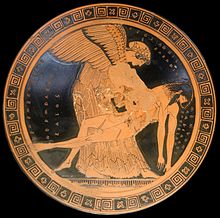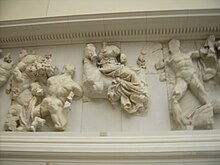Eos (mythology)

( red-figure chalice from Attica , around 490 BC, found in Capua )

Eos ( ancient Greek Ἠώς , Ēōs ) is the "goddess of the dawn" in Greek mythology . Its Roman equivalent is the aurora , after which the red-greenish polar light is named.
myth
ancestry
Eos is commonly thought of as a titanine . According to Hesiod , she is the daughter of the titan couple Hyperion and Theia . Her siblings are the sun god Helios and the moon goddess Selene . According to the Homeric Hymns , on the other hand, like the "tireless" Helios and the "richly braided" Selene, the daughter of Hyperion and his sister Euryphaessa , she is "the one who shines far and wide". Ovid , like Valerius Flaccus, calls her Pallantis , that is, daughter of Pallas .
meaning
Eos' throne stood at the source of the Ocean . She appeared every morning with her team from the Ocean , which is why she was nicknamed Erigeneia , "the early awakening". She drove ahead of her brother Helios on his journey across the sky in her own car. Their horses were called Phaethon ("shimmer" or "the shining one") and Lampos ("shine" or "the light one").
Homer describes Eos as a graceful , beautifully curly, rose-armed and rose-fingered deity (ῥοδοδάκτυλος Ἠώς rhododactylos Ēōs ) in a saffron- colored dress.
partner
With her first husband, the Titan Astraios , Eos had many children, in addition to the Eosphoros ( morning star - Roman Lucifer ) also the four winds Zephyr , Notos , Boreas and Euros .
Eos and Ares
A fragment of a poem by the poet Sappho shows that Eos' love affair with the god of war Ares enraged Aphrodite , the goddess of love, who filled Eos with an insatiable desire for young mortal men out of revenge. Since then, when Eos moved over the horizon in the morning, she had to look everywhere for young men or boys. This made her face flush with shame and the sky flushed with her. Eos' relationships with mortals, however, are not uncommon. Hesiod lists her association with Cephalus in a long list of goddess-mortal relationships from which children spring. The acroterion of Caere in the State Museum in Berlin shows Eos with a boy who has not yet outgrown his size after childhood.
Eos and Tithonos
She kidnapped and married Tithonus , a prince from the blood of Ilos , and asked Zeus to immortality for him. However, unlike Selene for her lover Endymion , she forgot to ask for eternal youth. So Tithonus grew old, unable to die, he shrank completely, and his voice became more and more shrill, so that Zeus finally turned him into a cicada out of pity , which has accompanied Eos ever since. Both had two sons, Emathion (who was killed by Heracles ) and Memnon , king of the Aithiopians, whom Achilles slew in the battle for Troy , as Arktinos of Miletus described in his lost work Aethiopis . Eos kidnapped the body of Memnon and brought it back to Aithiopia . She still weeps for his death, and her tears fall as dew from the sky every morning. Memnon's grave near Thebes was labeled with the Colossi of Memnon , who made a sound every morning that sounded like a harp.
More love affairs
Eos had love affairs with the mortals Clitus and Orion, among others . Her affair with the Athenian Cephalus led to the death of his wife Pokris. Both sons were Phaëton (according to other sources a son of Helios ). She is also said to have had a love affair with the boy Ganymede , whom Eos or Zeus had kidnapped to Olympus.
Representation in antiquity
In Greek art, Eos has been used since the 6th century BC. Shown winged. A well-known representation can be found on the Pergamon Altar . An Etruscan mirror shows an Eos with four wings that brings the dead Memnon to Aithiopia.
Dolphins and seahorses are often depicted under the chariot of the Eos to denote the Oceanos.
Representations of Eos chasing mortal boys and men or carrying them away were very popular on Attic vases; Kaempf-Dimitriadou's catalog gives 147 examples.
- Eos seizes Tithonos , Kylix of the Telephos Painter (Boston 95.28). Museum of Fine Arts, Boston .
- Eos and Kephalos , amphora of the Niobid painter , Rijksmuseum van Oudheden , Leiden (PC 78: ARV2 605, no. 58; LIMC III, 1986, p. 761 no. 77, plate 77)
- Eos and Kephalos , Pelike des Niobiden-Painter, Königsberg (LIMC III, 1986, p. 761 No. 76, plate 76)
Places of worship
Her cult is rare, only in Athens she seems to have been worshiped, probably because of her connection with Cephalos. This is how Eos and Cephalos were depicted on the temple of the Athenians in Delos .
Interpretations
According to Robert von Ranke-Graves , Eos developed from the blood-fingered Vedic mother goddess Ushas . He interprets Eos 'love affairs with young mortals as allegories: Dawn makes lovers' nocturnal passions flare up again.
Family tree of the titans (simplified)
| Uranus | ← - | Gaia | ← - | chaos | |||||||||||||||||||||||||||
| Family of gods | of the titans | ||||||||||||||||||||||||||||||
| Hyperion | Theia | ||||||||||||||||||||||||||||||
| Selene | Eos | Helios | |||||||||||||||||||||||||||||
literature
- Jakob Escher-Bürkli : Eos . In: Paulys Realencyclopadie der classischen Antiquity Science (RE). Volume V, 2, Stuttgart 1905, Col. 2657-2669.
- Mary R. Lefkowitz: “Predatory” Goddesses. In: Hesperia . Volume 71, Issue 4, 2002, pp. 325-344.
- Tobias Leuker: Eos. In: Maria Moog-Grünewald (Ed.): Mythenrezeption. The ancient mythology in literature, music and art from the beginnings to the present (= Der Neue Pauly . Supplements. Volume 5). Metzler, Stuttgart / Weimar 2008, ISBN 978-3-476-02032-1 , pp. 258-261.
Web links
- Eos in Meyer's Konversationslexikon
- Greek and Roman gods and legendary figures: Eos
- Eos in the Theoi Project
Remarks
- ↑ Hesiod, Theogony 371 ff.
- ↑ Homeric Hymn 31 (To Helios).
- ↑ Ovid, Fasti 4,373.
- ↑ Valerius Flaccus, Argonautica 2.72.
- ↑ Hesiod , Theogony 378-382.
- ↑ Homer , Odyssey 23,246.
- ↑ Homer, e.g. B. Iliad 1.477 and 6.175.
- ↑ Homer, Iliad 8: 1 and 24, 695.
- ↑ Sappho, fragment 140.
- ↑ Hesiod, Theogony 967-968
- ^ Marilyn Y. Goldberg: The "Eos and Cephalos" from Caere: Its Subject and Date. In: American Journal of Archeology . Volume 91, No. 4, 1987, pp. 605-614 Fig. 1
- ↑ Hesiod, Theogony 984 ff. And Virgil , Aeneis 1,489.
- ↑ Sherman E. Lee: An Etruscan Mirror with Eos and Memnon. In: Bulletin of the Cleveland Museum of Art. Volume 40, No. 2, 1953, pp. 32-35, here: p. 33.
- ↑ Homer, Odyssey 15,572-575.
- ↑ Homer, Odyssey 5, 118–128.
- ↑ Sherman E. Lee: An Etruscan Mirror with Eos and Memnon. In: Bulletin of the Cleveland Museum of Art. Volume 40, No. 2, 1953, pp. 32-35, here: p. 33.
- ^ Marilyn Y. Goldberg: The "Eos and Cephalos" from Caere: Its Subject and Date. In: American Journal of Archeology. Volume 91, No. 4, 1987, p. 608.
- ^ Sophia Kaempf-Dimitriadou: The love of the gods in the Attic art of the 5th century. v. Chr. Bern 1969, pp. 76-109.
- ^ Martin Robertson: A History of Greek Art. Cambridge University Press, Cambridge 1975, p. 356.
- ↑ Robert von Ranke-Graves: Greek Mythology . Rowohlt Verlag, Reinbek near Hamburg 2007.




